
| myArmoury.com is now completely member-supported. Please contribute to our efforts with a donation. Your donations will go towards updating our site, modernizing it, and keeping it viable long-term.
Last 10 Donors: Anonymous, Daniel Sullivan, Chad Arnow, Jonathan Dean, M. Oroszlany, Sam Arwas, Barry C. Hutchins, Dan Kary, Oskar Gessler, Dave Tonge (View All Donors) |
| Author |
Message |
Fernando Viana

Location: PORTUGAL Joined: 13 Aug 2007
Posts: 62
|
 Posted: Mon 03 Nov, 2008 10:32 am Post subject: Walloon sword for coments Posted: Mon 03 Nov, 2008 10:32 am Post subject: Walloon sword for coments |
 |
|
Hello, would somebody help?
This piece is on its way to my little collection.
Said to be German, dated around 1700.
Blade length 91, 5 cms
Width 38 mm
There are some numbers and letters marked on the pommel - LCR N118 - said to be regimental markings.
I would like to know your opinnion on this sword, namely on its age, country of origin and, if possible, an idea of the markings provenance.
Thanks a lot in advance.
Fernando
.
 Attachment: 27.74 KB Attachment: 27.74 KB

 Attachment: 96.83 KB Attachment: 96.83 KB

 Attachment: 90.87 KB Attachment: 90.87 KB
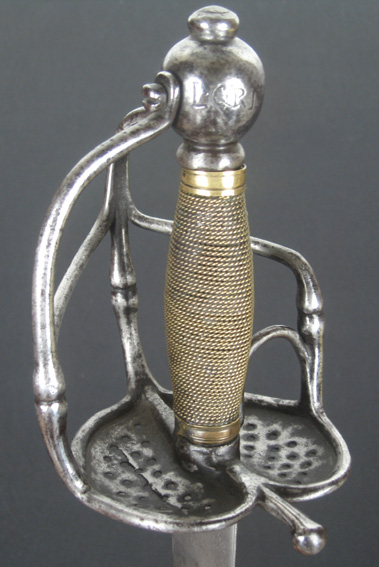
 Attachment: 82.51 KB Attachment: 82.51 KB
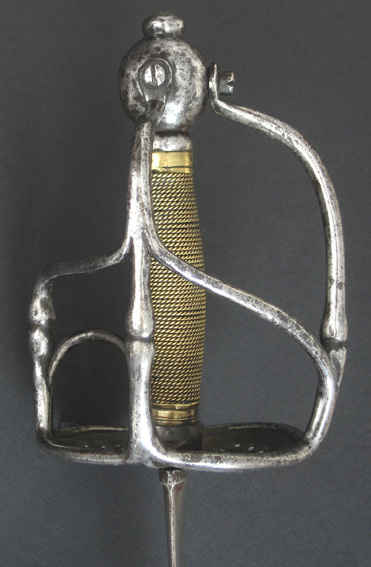
 Attachment: 141.23 KB Attachment: 141.23 KB
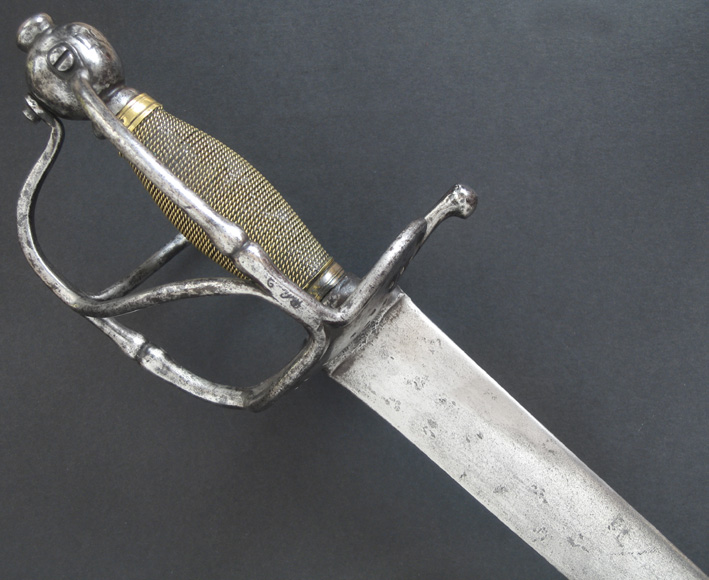
 Attachment: 118.46 KB Attachment: 118.46 KB
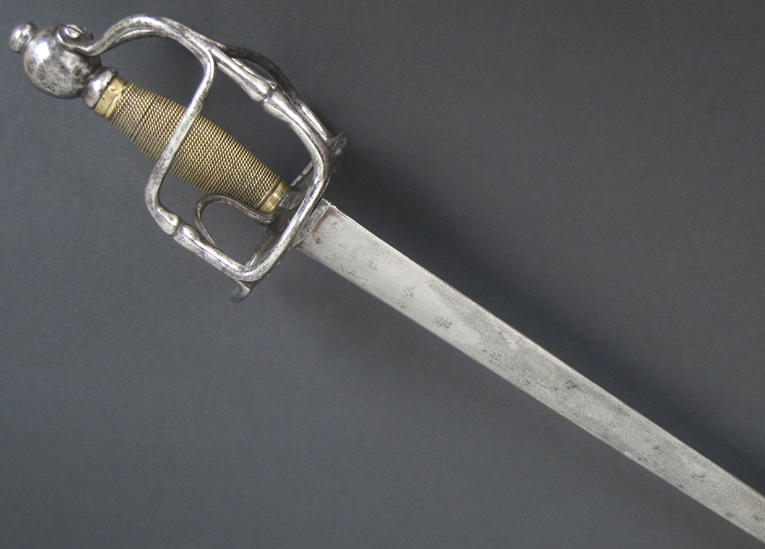
 Attachment: 99.67 KB Attachment: 99.67 KB
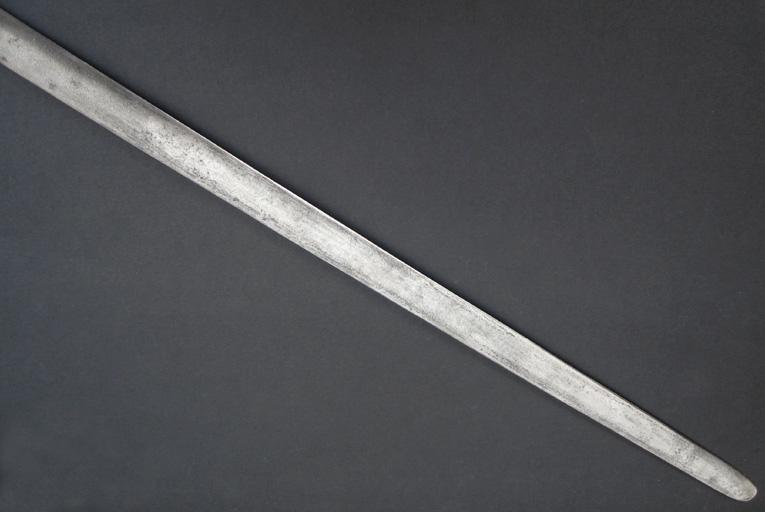
|
|
   |
 |
Roger Hooper

|
 Posted: Tue 04 Nov, 2008 1:23 pm Post subject: Posted: Tue 04 Nov, 2008 1:23 pm Post subject: |
 |
|
That is a handsome sword. I've looked at a few 17th sword photos and this is the first time that I've seen writing on the pommel. I can't see it, but is there a maker's mark (or any other mark) on the blade? I wonder if sometime in it's history somebody decided to blunt the sword tip.
Some would disagree, but I don't consider this a Walloon sword. In my tighter definition, I say Walloon swords were made around 1650 in Solingen for Amsterdam town guard and other Dutch entities, and about 30 years later France ordered them from Solingen (through Amsterdam) as their first standard army issue sword. They have a pear-shaped pommel with a knucklebow screwed to it, but no side branches. The counterguard is heart shaped with a star and smaller circle perforation pattern. The picture below shows a typical Walloon sword.
In my opinion, better names for your sword might be:
1 - German Military sword
2 - Haudegen (Hewing or Shearing sword)
3 - Felddegen (field, or battlefield sword)
For more pictures and a discussion of these swords see this thread - http://www.myArmoury.com/talk/viewtopic.php?t=13795
 Attachment: 16.68 KB Attachment: 16.68 KB
Walloon Sword circa 1650 [ Download ]
|
|
  |
 |
Morgan Butler

|
 Posted: Tue 04 Nov, 2008 2:37 pm Post subject: Posted: Tue 04 Nov, 2008 2:37 pm Post subject: |
 |
|
Perhaps if it had big germanic quillons, as I have seen on, some, I might call it something like a "late 17th to early 18th german military cut and thrust", There are few of these available where I live. But I think your sword qualifies as a German "walloon pattern" sword. And a damn nice one as well. Congrats!
inkothemgard!
|
|
  |
 |
Fernando Viana

Location: PORTUGAL Joined: 13 Aug 2007
Posts: 62
|
 Posted: Tue 04 Nov, 2008 4:01 pm Post subject: Posted: Tue 04 Nov, 2008 4:01 pm Post subject: |
 |
|
Thank you so much for your input Roger,
Eventualy i have already had an overview to the link you now appoint, where i noticed your 'tighter' definition of Walloon sword, together with the Felddegen and Haudegen aproaches.
OTHH, i have also observed that the guard of the Walloon example depicted by Nathan Robinson on his Spotlight article 'The Schiavona and its Influences', has side and diagonal branches.
http://www.myArmoury.com/feature_spot_schia.html
I see that you note that the markings on the pommel of my example are unusual. This is a point i consider to be vital for its identification; i hope someone pops up with its decoding.
Concerning marks on the blade, i haven't yet received the sword; the pictures i posted are those from the seller's website. But i don't think there are any; soon i will check.
About the blunt tip, i must also check it when i have in hand, but i have already read the most varied opinnions on how this type of tip appears in this type and period of swords.
Thank you very much for your info and congrats, Morgan,
Concerning the answers i have seeked for my questions, i will adjust my sword's age to late 17th to early 18th century, its provenance being Germany, and will acomodate its typology to a 'digestive' Walloon pattern ... if Roger doesn't mind 
Fernando
|
|
   |
 |
Roger Hooper

|
 Posted: Wed 05 Nov, 2008 9:57 am Post subject: Posted: Wed 05 Nov, 2008 9:57 am Post subject: |
 |
|
| Morgan Butler wrote: | | Perhaps if it had big germanic quillons, as I have seen on, some, I might call it something like a "late 17th to early 18th german military cut and thrust", There are few of these available where I live. But I think your sword qualifies as a German "walloon pattern" sword. And a damn nice one as well. Congrats! |
Like I said, I have a very narrow idea about what makes a Walloon sword. I even think there is a fairly standard blade style, which is heretical - most think a Walloon is only defined by it's hilt and that their blades are variable.
So Morgan, please tell me what is your definition of a Walloon Sword?
Fernando, another thing about your sword. I think its unusual for a sword dated that late to have the knucklebow and branches screwed into the pommel. By that time, I think the screws had been discarded and the branches inserted themselves into depressions in the pommel. But there are always exceptions to the general rules.
And that really is a beautiful sword. It is pleasing like that the double lobes on the branches and knucklebow have a restrained shape and aren't as bulbous or exaggerated as they are on some other 17th century German swords.
|
|
  |
 |
Fernando Viana

Location: PORTUGAL Joined: 13 Aug 2007
Posts: 62
|
 Posted: Wed 05 Nov, 2008 2:54 pm Post subject: Posted: Wed 05 Nov, 2008 2:54 pm Post subject: |
 |
|
Hi Roger,
As i was about to read your post, the courier rang the bell to deliver the sword.
Two important details i now observed:
First is the inscription on the pommel; there is one more (tiny) digit in the legend, which confirms this is definitely a regimental numeration. The correct inscription is: LCR Nº 118, not punched but hand engraved (chiseled) in a crude manner. Oh, i wish i could have this marking decoded. If it were english, one could imagine the initials of Light Cavalry Regiment, but both in German and in Dutch one or another letter doesn't coincide ... at least in the translating machine.
The second is, as i guessed since i saw the first site pictures, a faded inscription engraved on the hilt side bar, most certainly the name of the sword user. After a zillion trials, i managed to get a close up picture where we can discern such detail.
Back into the Walloon typology, i fully understand your demanding interpretation of this sword pattern, but i have been noticing that many a people includes the multi bar hilted styles into the same family; and some of them have enough knowledge to figure out which is which, given the doubt that they call such variations Walloons just to make it easy.
I have spotted a Spanish article called 'Espadas y sables en la Guerra de Sucesión, 1702-1714' included in the page 'CATALOGACION DE ARMAS' by JUAN L. CALVÓ, where both plain and multi bar patterns are labeled as Walloon guard swords.
http://www.catalogacionarmas.com/public/35-GuerraSucesion.pdf
As for considering the knuckle guard and side branches being screwed to the pommel, a system too early for the date of this sword, i would ask you on what date you actualy situate this sword ... or did you already mentioned that and i am missing it ? I have just had a look to a Portuguese book and it seems as the transition of methods took place between end XVII and beg. XVIII century, is that correct ?
Your coments will be welcome.
... And thanks for finding this a beautyful sword; that makes me proud, coming from you.
Fernando
.


|
|
   |
 |
|
Martijn Bakkes
|
 Posted: Wed 05 Nov, 2008 7:09 pm Post subject: Posted: Wed 05 Nov, 2008 7:09 pm Post subject: |
 |
|
| Fernando Viana wrote: |
The correct inscription is: LCR Nº 118, not punched but hand engraved (chiseled) in a crude manner. Oh, i wish i could have this marking decoded. If it were english, one could imagine the initials of Light Cavalry Regiment, but both in German and in Dutch one or another letter doesn't coincide ... at least in the translating machine.
|
Actually, LCR works fine for a Dutch translation. Although, in military notation RLC might be likely ( don't know the military well enough to say which is more likely to be used ).
|
|
  |
 |
Roger Hooper

|
 Posted: Thu 06 Nov, 2008 7:04 am Post subject: Posted: Thu 06 Nov, 2008 7:04 am Post subject: |
 |
|
Fernando -
Actually, I don't think one can firmly date one of these sword types by the type of branch to pommel connection. Screws tend to be a 17th century phenomenon, and direct insertion a little later, but the two techniques show up on swords with the same date.
If you can get a copy, I recommend George C. Neumann's, Swords and Blades of the American Revolution. It shows black and white photos and specifications of hundreds of swords, dating from around 1640 to 1800 - hangers, cuttoes, sabers, other cavalry swords, cutlasses,and smallswords. There are photos of about 20 German Military swords scattered through the book. I saw one, dated at 1700-1740 very similar to yours. There is a photo of another that has the knucklebow directly inserted and another branch screwed into the pommel, so what can I say? 
|
|
  |
 |
Fernando Viana

Location: PORTUGAL Joined: 13 Aug 2007
Posts: 62
|
 Posted: Thu 06 Nov, 2008 9:57 am Post subject: Posted: Thu 06 Nov, 2008 9:57 am Post subject: |
 |
|
Thank you Roger.
A while ago i have tried to acquire Neumann's book, but i ended up receiving the 'wrong' work, called Collector's IIlustrated Encyclopedia of the American Revolution ( one gets exhausted when speaking out this title).
I am now buying the 'right' one, for a nice price.
Speaking of age in connection with knucklebow fixation to the pommel, i have this Portuguese 'regional' cup hilted sword, with the insertion method, which was dated by some connoisseur as from thje period of King Dom João V (crowned 1707).
Fernando
.





|
|
   |
 |
Fernando Viana

Location: PORTUGAL Joined: 13 Aug 2007
Posts: 62
|
 Posted: Thu 06 Nov, 2008 10:10 am Post subject: Posted: Thu 06 Nov, 2008 10:10 am Post subject: |
 |
|
| Martijn Bakkes wrote: | | ... Actually, LCR works fine for a Dutch translation. Although, in military notation RLC might be likely ( don't know the military well enough to say which is more likely to be used ). |
Thank you Martijn,
I will consider that.
Just for perusal, in Portuguese the initials would also be the same, but with a different sequence ... Regimento de Cavalaria Ligeira.
BTW, how do you spell the three words (LCR) in Dutch ?
Met vriendelijke groeten
Fernando
|
|
   |
 |
|
Martijn Bakkes
|
 Posted: Thu 06 Nov, 2008 11:43 am Post subject: Posted: Thu 06 Nov, 2008 11:43 am Post subject: |
 |
|
"Licht(e) Cavalerie Regiment" would be it in normal speech... Military it might be "Regiment Lichte Cavalerie".
I couldn't find either as an acronym though, they seem to be more specified usually... Dragoons, Hussars, lancers etc.
With that in mind the C could be for Cossack, which would make it possible to be German as well, as cavalry would be spelled with a k in german.
|
|
  |
 |
Fernando Viana

Location: PORTUGAL Joined: 13 Aug 2007
Posts: 62
|
 Posted: Fri 07 Nov, 2008 5:08 pm Post subject: Posted: Fri 07 Nov, 2008 5:08 pm Post subject: |
 |
|
Thanks a lot Martijn,
I will follow that track.
Fernando
|
|
   |
 |
Fernando Viana

Location: PORTUGAL Joined: 13 Aug 2007
Posts: 62
|
 Posted: Mon 10 Nov, 2008 2:45 pm Post subject: Posted: Mon 10 Nov, 2008 2:45 pm Post subject: |
 |
|
I still struggle to decode the (possible) regimental marks in my example ... Prussian ?
BTW, Indeed the habit of including multi bar hilted specimens in the Walloon typology was rather generalized. I was paging through my 'ancient' encyclopedia and found this drawing, defining the various types of swords.
Just look at example 8).
.

|
|
   |
 |
|
|
You cannot post new topics in this forum
You cannot reply to topics in this forum
You cannot edit your posts in this forum
You cannot delete your posts in this forum
You cannot vote in polls in this forum
You cannot attach files in this forum
You can download files in this forum
|
All contents © Copyright 2003-2024 myArmoury.com — All rights reserved
Discussion forums powered by phpBB © The phpBB Group
Switch to the Basic Low-bandwidth Version of the forum
|

